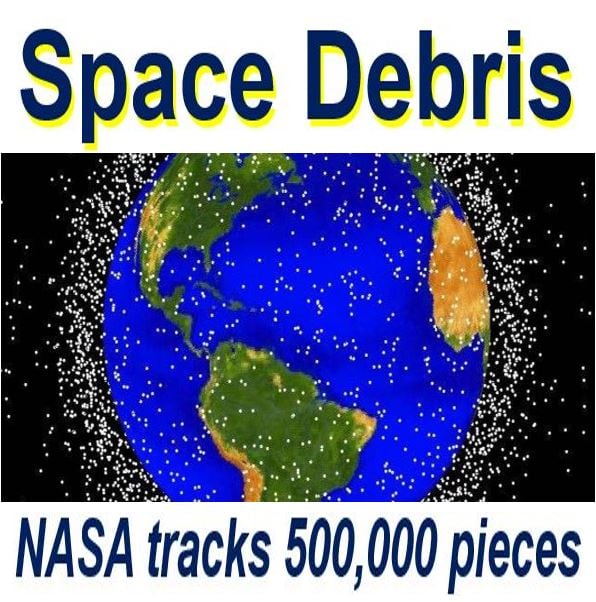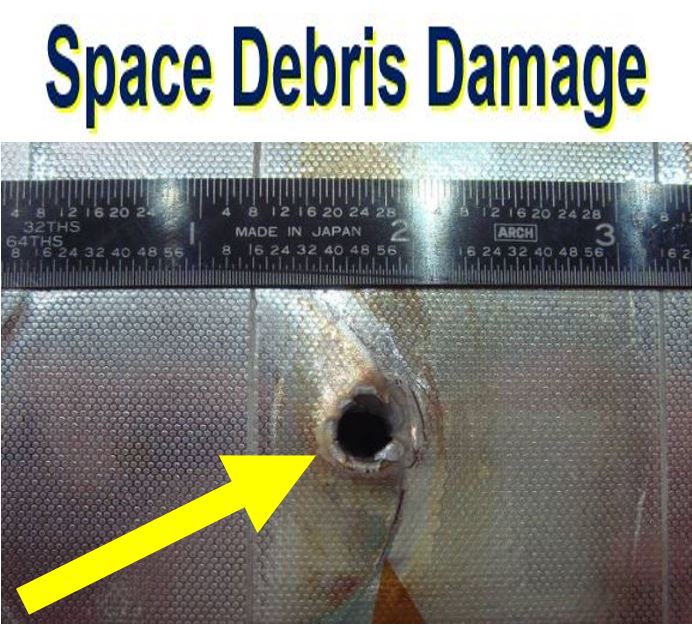There is small crack or chip on the glass of a window of the International Space Station, caused by one of the millions of pieces of debris that orbits the Earth at extremely high speed. Having a spacecraft window lose its glass is an astronaut’s ultimate nightmare. However, this latest crack poses no threat to the crew members, NASA says.
The chipped window is in the ISS’ Cupola module, which has large bay windows so that the crew can see outside. The module houses one of the ISS’ two robotic work stations that crew members use to manipulate the large robotic arm that they can see through the right window.
The Cupola module is attached to the nadir side (underside) of the ISS, and also gives a full panoramic view of Earth.
 Twitter post by Major Peake showing a chip on an ISS window, caused by a piece of space debris that was probably travelling at nearly eight times the speed of a bullet when it is fired from an M16 rifle. (Image: twitter.com/astro_timpeake)
Twitter post by Major Peake showing a chip on an ISS window, caused by a piece of space debris that was probably travelling at nearly eight times the speed of a bullet when it is fired from an M16 rifle. (Image: twitter.com/astro_timpeake)
In a Tweet yesterday, British astronaut Tim Peake posted a picture of an impact chip in a Cupola window with the following comment: “Often asked if @Space_Station is hit by space debris. Yes – this chip is in a Cupola window, glad it is quadruple glazed!”
Although the Twitter posting is just one day old, the photo was taken in April.
Window has a 7 mm-diameter chip
According to the European Space Agency (ESA), the fused-silica and borosilicate-glass windows sometimes suffer from tiny pieces of space debris.
The one Major Peake photographed a month ago shows a 7 mm-diameter chip that was gouged out by the impact of a very small piece of space debris. ESA thinks it was probably a paint flake or tiny metal fragment just a few thousandth of a millimetre across.
 Many of the 20,000 pieces of space debris that are larger than a cricket ball could literally smash the ISS to pieces. (Image: nasa.gov)
Many of the 20,000 pieces of space debris that are larger than a cricket ball could literally smash the ISS to pieces. (Image: nasa.gov)
To cater for such events, the ISS is provided with extensive shielding around all vital crew and technical areas, so that small collisions, like this one, pose no threat.
While a small chip like the one in the photograph may be minor and of little concern, larger pieces of debris would pose a serious threat. ESA says that a space object up to 1 cm across could disable an instrument or a critical flight system on a satellite.
Anything larger than 1 cm would probably be able to penetrate the shields of the ISS’ crew modules, while anything bigger than 10 cm could potentially shatter the whole spacecraft into pieces.
Holger Krag, Head of ESA’s Space Debris Office, said:
“ESA is at the forefront of developing and implementing debris-mitigation guidelines, because the best way to avoid problems from orbital debris is not to cause them in the first place.”
“These guidelines are applied to all new missions flown by ESA, and include dumping fuel tanks and discharging batteries at the end of a mission, to avoid explosions, and ensuring that satellites reenter the atmosphere and safely burn up within 25 years of the end of their working lives.”
Space Debris and the ISS
NASA says it tracks over half-a-million pieces of debris or ‘space junk’ orbiting the Earth. They travel at very high speed – up to 17,500 mph (28,163 km/h) – which it says is easily fast enough for a small piece of debris to damage a spacecraft or satellite. An M16 rifle, with a 20″ barrel and a 55 grain bullet, travels at just 2,250 mph (3300 ft/second).
 The windows of the Cupola module that is attached to ISS. This image was taken by ESA astronaut Luca Parmitano. She jokingly posted on Twitter: ‘Proof that Earth is indeed round.’ (Image: esa.int/spaceinimages)
The windows of the Cupola module that is attached to ISS. This image was taken by ESA astronaut Luca Parmitano. She jokingly posted on Twitter: ‘Proof that Earth is indeed round.’ (Image: esa.int/spaceinimages)
On its website, NASA wrote:
“The rising population of space debris increases the potential danger to all space vehicles, but especially to the International Space Station, space shuttles and other spacecraft with humans aboard.”
“NASA takes the threat of collisions with space debris seriously and has a long-standing set of guidelines on how to deal with each potential collision threat. These guidelines, part of a larger body of decision-making aids known as flight rules, specify when the expected proximity of a piece of debris increases the probability of a collision enough that evasive action or other precautions to ensure the safety of the crew are needed.”
Types of orbital Debris
There are two types of space debris:
1. Artificial (man-made) particles: which are in orbit around the Earth; often referred to as orbital debris.
2: Natural (meteoroid) particles: which are in orbit around the Sun.
Orbital debris is any artificial object in orbit around the Earth, which no longer serves a useful function, such as mission-related debris, fragmentation debris, non-functional spacecraft and abandoned launch vehicle stages.
 The space shuttle Endeavor had a major impact on its radiator during STS-118. The entry hole was about 1⁄4 inch, and the exit hole was twice as large. (Image: Wikipedia)
The space shuttle Endeavor had a major impact on its radiator during STS-118. The entry hole was about 1⁄4 inch, and the exit hole was twice as large. (Image: Wikipedia)
There are over twenty-thousand pieces of debris bigger than a softball (or cricket ball) orbiting our planet. There are more than 500,000 pieces that are larger than a marble, and literally millions and millions of smaller ones. The tiny ones cannot be tracked.
Even very small paint flecks can damage a spacecraft when travelling at over 17,000 mph.
NASA wrote:
“In fact a number of space shuttle windows have been replaced because of damage caused by material that was analyzed and shown to be paint flecks.”
“The greatest risk to space missions comes from non-trackable debris,” said Nicholas Johnson, NASA chief scientist for orbital debris.”
With so much debris out there, NASA and ESA say there are surprisingly few disastrous impacts.
Threatening space debris guidelines
NASA says it has a set of long-standing guidelines that are used to determine whether a nearby or approaching piece of debris represents a threat to a spacecraft.
According to NASA:
“Debris avoidance maneuvers are planned when the probability of collision from a conjunction reaches limits set in the space shuttle and space station flight rules.”
“If the probability of collision is greater than 1 in 100,000, a maneuver will be conducted if it will not result in significant impact to mission objectives. If it is greater than 1 in 10,000, a maneuver will be conducted unless it will result in additional risk to the crew.”
Debris-avoidance manoeuvres are typically small and occur from one to a number of hours before the estimated collision time.
The ISS has a couple of options available if its crew wants to move it out of the path of a piece of flying debris. The Russian Progress supply ships can use their thrusters when they are docked at the space station.
When no supply ship is docked, thrusters on the Russian Zvezda service module can be used.
Video – Space debris threat for ISS crew
If all else fails, ISS crew members can go to the Soyuz space capsules and wait to see whether a collision takes place. If it does, in a few seconds they can detach from the space station and try to return to Earth.
